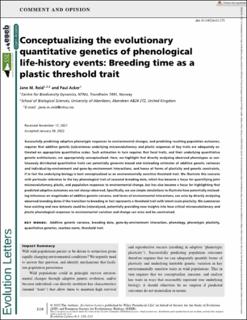| dc.contributor.author | Reid, Jane Margaret | |
| dc.contributor.author | Acker, Paul | |
| dc.date.accessioned | 2023-02-07T10:11:10Z | |
| dc.date.available | 2023-02-07T10:11:10Z | |
| dc.date.created | 2022-02-01T13:54:39Z | |
| dc.date.issued | 2022 | |
| dc.identifier.citation | Evolution Letters. 2022, 6 (3), 220-233. | en_US |
| dc.identifier.issn | 2056-3744 | |
| dc.identifier.uri | https://hdl.handle.net/11250/3048827 | |
| dc.description.abstract | Successfully predicting adaptive phenotypic responses to environmental changes, and predicting resulting population outcomes, requires that additive genetic (co)variances underlying microevolutionary and plastic responses of key traits are adequately estimated on appropriate quantitative scales. Such estimation in turn requires that focal traits, and their underlying quantitative genetic architectures, are appropriately conceptualized. Here, we highlight that directly analyzing observed phenotypes as continuously distributed quantitative traits can potentially generate biased and misleading estimates of additive genetic variances and individual-by-environment and gene-by-environment interactions, and hence of forms of plasticity and genetic constraints, if in fact the underlying biology is best conceptualized as an environmentally sensitive threshold trait. We illustrate this scenario with particular reference to the key phenological trait of seasonal breeding date, which has become a focus for quantifying joint microevolutionary, plastic, and population responses to environmental change, but has also become a focus for highlighting that predicted adaptive outcomes are not always observed. Specifically, we use simple simulations to illustrate how potentially misleading inferences on magnitudes of additive genetic variance, and forms of environmental interactions, can arise by directly analyzing observed breeding dates if the transition to breeding in fact represents a threshold trait with latent-scale plasticity. We summarize how existing and new datasets could be (re)analyzed, potentially providing new insights into how critical microevolutionary and plastic phenological responses to environmental variation and change can arise and be constrained. | en_US |
| dc.language.iso | eng | en_US |
| dc.publisher | Wiley Periodicals LLC on behalf of Society for the Study of Evolution (SSE) and European Society for Evolutionary Biology (ESEB). | en_US |
| dc.rights | Navngivelse 4.0 Internasjonal | * |
| dc.rights.uri | http://creativecommons.org/licenses/by/4.0/deed.no | * |
| dc.title | Conceptualizing the evolutionary quantitative genetics of phenological life-history events: Breeding time as a plastic threshold trait | en_US |
| dc.title.alternative | Conceptualizing the evolutionary quantitative genetics of phenological life-history events: Breeding time as a plastic threshold trait | en_US |
| dc.type | Peer reviewed | en_US |
| dc.type | Journal article | en_US |
| dc.description.version | publishedVersion | en_US |
| dc.source.pagenumber | 220-233 | en_US |
| dc.source.volume | 6 | en_US |
| dc.source.journal | Evolution Letters | en_US |
| dc.source.issue | 3 | en_US |
| dc.identifier.doi | 10.1002/evl3.278 | |
| dc.identifier.cristin | 1996370 | |
| dc.relation.project | Norges forskningsråd: 223257 | en_US |
| cristin.ispublished | true | |
| cristin.fulltext | original | |
| cristin.qualitycode | 1 | |

